Are You Leaning Forward During Squats? Here’s the Fix
Author:
Reviewed by:
(21 years of Oly Lifting experience)
Unlock your full potential by engaging with our experts and community! Have questions about your fitness journey or looking for expert advice on weightlifting techniques? Don’t hesitate — leave a comment below and Sergii Putsov will provide a personalized answer and insights to help you reach your goals.
Torokhtiy is reader-supported. Some links are affiliate links, and we may earn a commission at no extra cost to you. See our disclosure page for details.
If one compound exercise has to be crowned above all, the squat is a serious contender. Squatting works a lot of muscles, builds strength, prevents injuries, and improves sports as well as everyday life activities.
There is always room to get better. One common error is leaning forward during squats. The use and placement of weights characterize multiple squat variations. In any case, you shouldn’t feel like standing on a seesaw that tips you back and forth. Otherwise, it jeopardizes the success and safety of your lifting routine. Let’s investigate the ins and outs of this case.
Why are you leaning forward during squats? There may be several reasons why you can’t squat without leaning forward, such as poor balance, unstable barbell, and stiff/weak muscles. However, carefully examining and correcting your form can get rid of an excessive forward lean in squats.
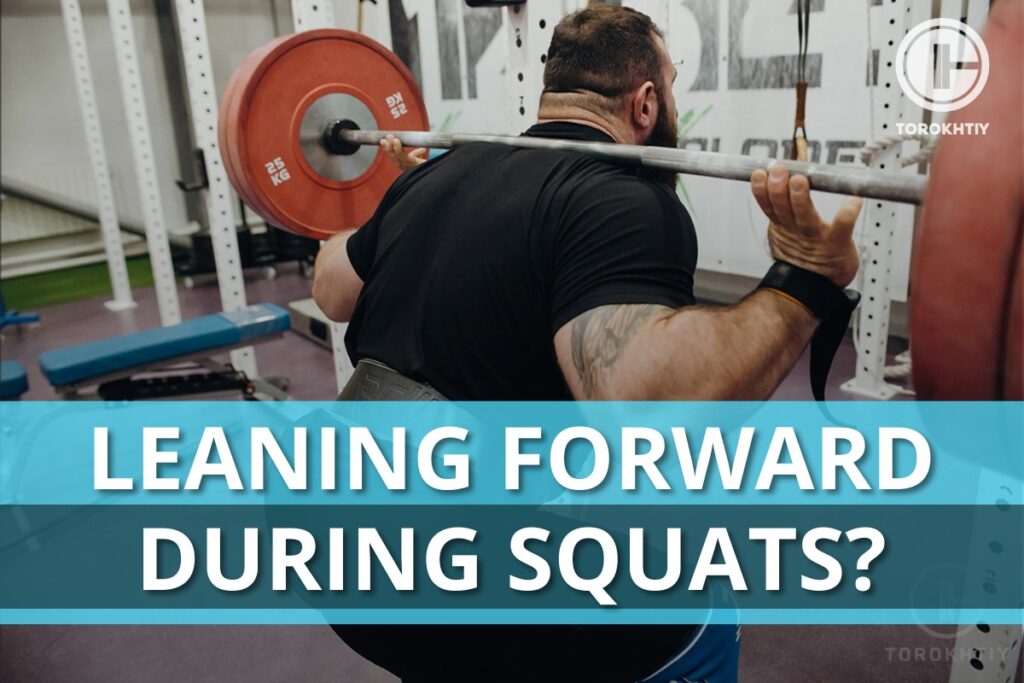
Leaning Forward When Squatting: Is This Wrong?
Most rookie lifters complain about their tendency of leaning forward in squats, which means they presume it to be a mistake. Everyone has heard of squatting with a vertical back. What you might not know is that your body proportions hugely determine squat mechanics.
Rusin and DeBell (2019) debunked the one-size-fits-all squat technique based on anatomical and anthropometrical differences. Moreover, Bret Contreras exposed it much earlier in a remarkable case study. Two women of similar height but visibly different thigh and trunk proportions were recorded doing squats.
One with short femurs and a long torso squatted deep with an upright posture, while another with longer femurs and a shorter torso had to lean forward.
In a nutshell, how far you can incline without compromising the form, spinal integrity, and access to hip musculature depends on your torso and thigh bone leverages. A slight forward lean becomes crucial for maintaining balance if you possess longer femurs.
So, should you lean forward when squatting intentionally? No, stay as upright as possible, but not everyone can achieve a 45-degree back angle. A more viable form-check alternative is ensuring the midfoot balance.
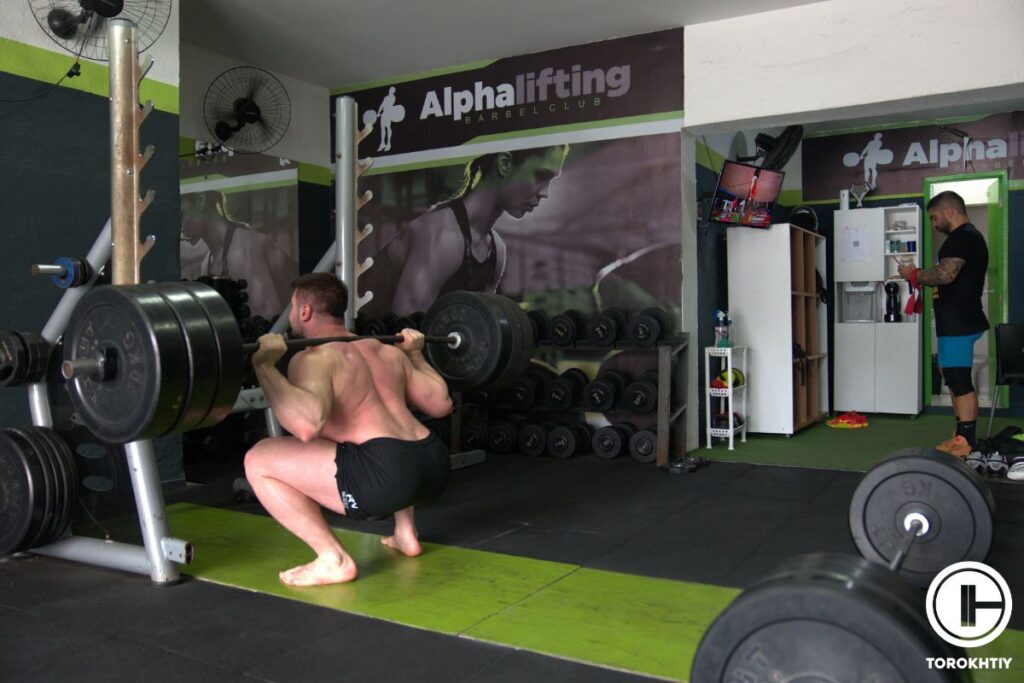
Meanwhile, the barbell must stay over the middle of your foot – not heels, not toes – over your midfoot. Secondly, the bar path must remain along a vertical axis throughout the movement.
If you move horizontally while getting into or out of the hole, that’s a problem. Before spotting this particular issue’s reasons and remedies, let’s revise the basic squat biomechanics.
- Choose a comfortable foot placement, i.e., hip-width apart. Start from a narrower stance to reduce compressive forces at the knees. From there, settle at a distance that makes a stable base.
- Knees must move in the line of toes. No valgus (caving in) or varus (pushing out) motion should be allowed at any movement phase. However, feet can be locked slightly outward.
- To minimize shear and compression of the lumbar spine, rule out any lateral movement, spinal flexion, and excessive forward lean in squats. A straight or upward gaze may prove beneficial.
- A significant depth must be reached. Quads development is maximum at parallel squats, while deeper angles further strengthen hips. Overall, a slow and controlled tempo is preferred for injury prevention.
Why Do You Lean Forward When You Squat? Possible Reasons and Solutions
Now, you know whether your forward lean is induced by a fault of your own that needs correction. We’ve grouped major causes into three categories with their respective solutions.
1. The Lack of Balance
Poor balance is a frequent and famous cause of leaning forward during squats. It’s generally seen among beginners without much experience, but nobody is truly exempted.
When you lose the balance, you feel like falling on your face, back, or sideways. Keeping the entire foot planted becomes difficult. As a result, your torso initiates a forward lean to help your lower body relax and stabilize.
Solution 1.1: Control Your Gaze
The first thing to try is maintaining a neutral head posture with a straight or slightly upward gaze. It might sound ridiculous, but looking down at the floor often leads you to sway forward. Extensive research has been conducted on the effects of head and gaze direction on squat kinematics.
Solution 1.2: Activate Your Feet
Another simple tweak is activating and cueing your feet. Think of them as a tripod with thumb toe, pinkie toe, and heel making three contact points. Forget those ‘on your heels’ shouts. Distribute the weight evenly across your feet for better ground traction and stability.
Solution 1.3: Improve Ankle Joint Mobility
Work on your ankle mobility, especially dorsiflexion. Sitting deep with flat feet and straight knees asks for considerable ankle mobility. Otherwise, you have to raise your heels. Not only do you lose balance and lean forward, but muscle activity and knee track also change.
Solution 1.4: Purchase Squat Shoes
Investing in squat shoes goes a long way. Unlike cross-trainers and runners, these have wide, flat soles for greater ground coverage with elevated heel counters. Alternatively, you can place 10lb plates under heels, although it doesn’t substitute ankle stretches.
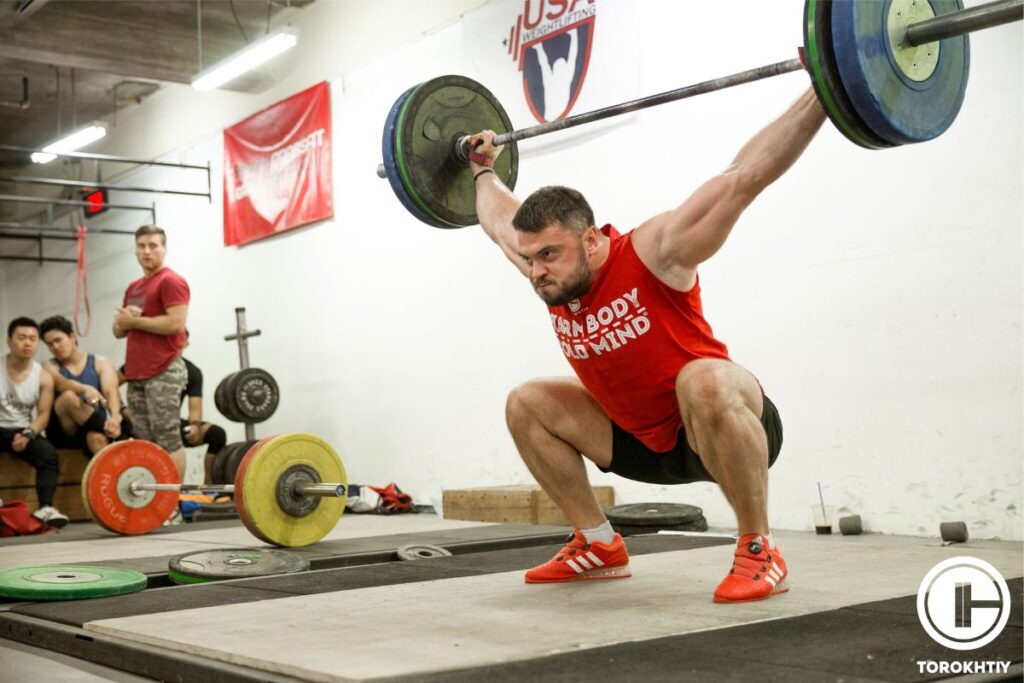
2. The Weakness of Muscles
The squat excites your core and paraspinal muscles, glutes, hip adductors and flexors, quads, hamstrings, and calves. Incorporating a barbell also brings your shoulders, arms, and back into the game.
Where squatting strengthens muscles, it warrants a certain level of prerequisite strength as well. If you can’t squat without leaning forward, lower training load/volume and spot weak links.
Solution 2.1: Train Your Quadriceps
Quads are primary knee extensors, so they must drive you out of the bottom position. Leaning forward while rising back up indicates that you should work on your quad muscles. Weak quads can’t propel all the weight by themselves, so you lean forward for recruiting glutes.
Solution 2.2: Brace the Core
A weak core can also provoke a forward lean during the ascending phase. If you notice that the malfunction originates from the lower back instead of the hip socket, develop the bracing and breathing technique – a.k.a. Valsalva maneuver – to uphold trunk rigidity and spinal stability.
Solution 2.3: Enhance Your Hip ROM
If you’re okay ascending but lost while sitting deep, open your hips. Tight hips don’t carry enough range of motion to allow a below-parallel, upright squat. Then, what happens? Your spine compensates either by overextending (forward lean) or flexing (butt wink/posterior pelvic tilt).
Solution 2.4: Don’t Ignore the Upper Back
If your back is rounding and knocking the spine out of its neutral as well as vertical path, you’re lacking upper back strength. The station muscles for the barbell (traps, rhomboids, rear delts) must be up for as many reps as you’re doing. Safety squat bars are built to reduce upper-body stress.
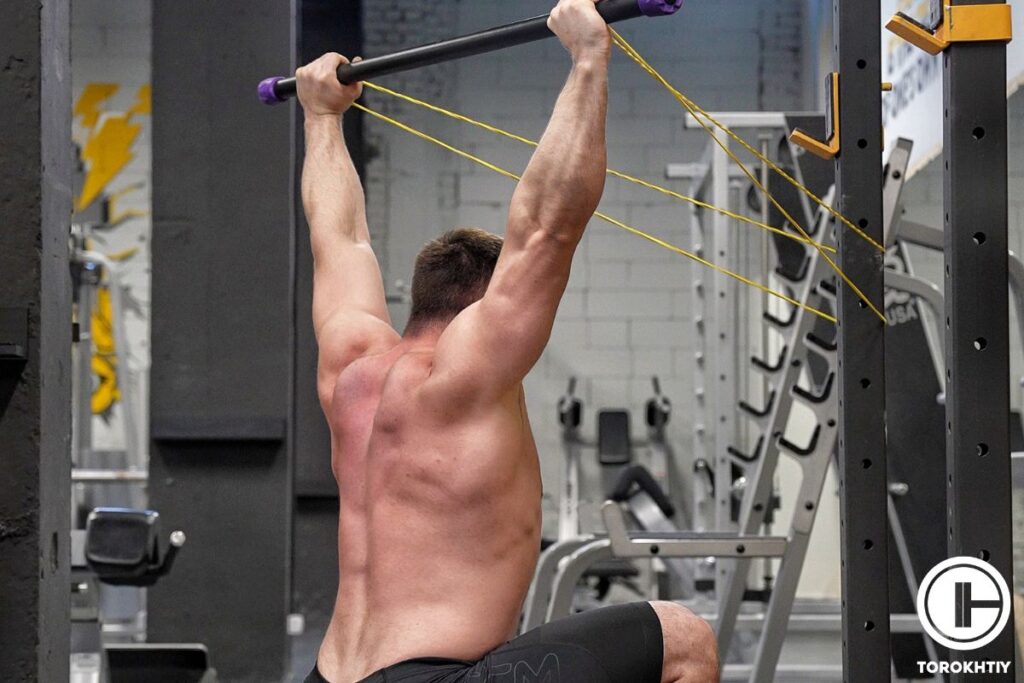
3. The Instability of the Bar
An unstable and misplaced barbell can disrupt the back squat setup. You may be having excellent lower-body strength and balance but still leaning forward when squatting. The bar rolls onto your neck and tips you forward while descending.
You’ll consequently go on your toes, flex your spine, and stare at the floor as the whole exercise becomes a constant struggle of managing the bar.
Solution 3.1: Open Up Your Chest
The number-one reason for an unstable bar is insufficient thoracic extension and shoulder external rotation. Your shoulders can’t keep up with flexing hips. They roll forward, pushing the bar up and making you lose balance in the meantime. If you can relate to this condition, open up your chest.
Solution 3.2: Go for Low-Bar Squats
You can switch to the low-bar position, which alters the center of mass and encourages a greater forward lean. You pin the bar on the posterior deltoids, not on top of the shoulders, where it could ride up. In fact, you can lift heavier with the low-bar variation compared to high-bar squats.
Follow us!

Free!
Get a 2-week Weightlifting Program as a bonus for the subscription to kickstart your training plan!

Free!
Solution 3.3: Decelerate the Descent
A straightforward recipe for messing up your squat is dive bombing. Don’t give in to gravity and control the descent. Otherwise, your hips won’t be able to shoot up against downward-pulling inertia without incorporating a forward lean, not to mention the lost eccentric training.
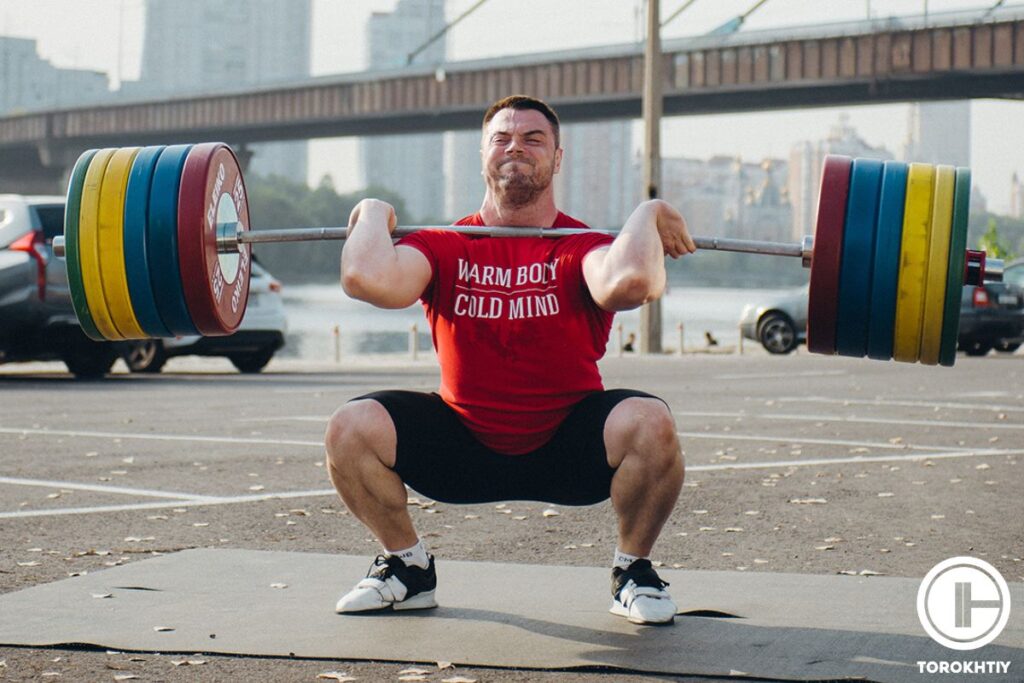
Solution 3.4: Keep Your Elbows Straight
Lastly, some folks raise their elbows while getting into the hole. It unnecessarily rolls up the bar. Besides a forward fall, it extends and exposes your wrists to a vulnerable position. Hence, keep your elbows tucked straight under the bar. Try a thumbless grip to undo the role of wrists.
Tips From the Champ
Shooting videos of yourself doing an exercise is critical to checking your form and bar path. Make sure the camera is stable, placed on an elevated surface, and covering the whole setup (from a back angle and a side view).
Olympic Weightlifting Champion
2 Drawbacks of Leaning Forward in Squats
If you don’t master the form and technique of any exercise, the result will be the same. You won’t be able to progress to heavier loads safely.
❌ Disadvantages to Progression
Targeted body parts get accustomed to a particular demand over time. You have to progressively overload (weight, reps, tempo, or rest) to increase workout intensity and muscular adaptations. If you can’t squat without leaning forward, the load is supported by your back more than the prime movers in thighs and hips. The seamless and secure progression will be impossible.
❌ Disadvantages to Protection
The study on the implication of the upper body bending during squats made a few conclusions. The activation of erector spinae and hamstrings increased with the opposite effect on quads. The intervertebral disc compression tripled. With a forward-leaning posture, we can infer that the chances of getting low back pain, slipped discs, and other lumbo-pelvic-hip complications are very high.
🔻GET A FREE PROGRAM DEMO: 12 Week Squat Program by Oleksiy Torokhtiy
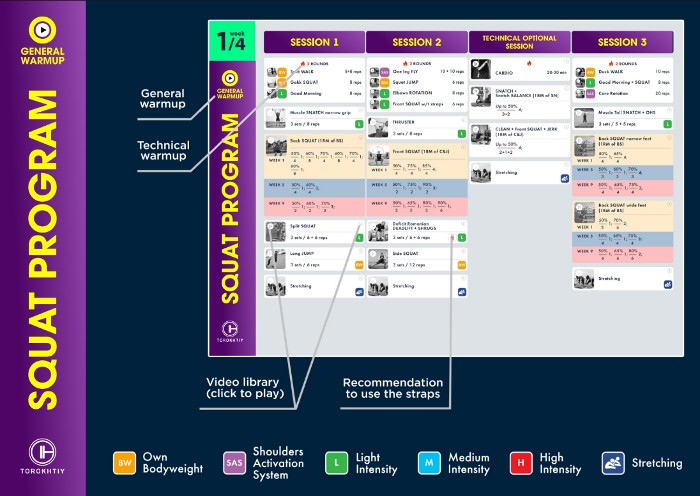
Do you want to double your squat strength? In just 12 weeks, you’ll be able to boost your squat results.
Enter your details and get a free demo (1 free week) of the squat program straight into your inbox.
7 Corrective Exercises that Will Help You Not to Lean Forward When Squatting
You might be going through the long list of reasons and solutions for excessive forward lean in squats and thinking: okay, I have to work on this joint or that muscle. But that’s half the equation. So, we’ll comprehensively recommend a set of stretching and strength exercises.
Tips From the Champ
Keep in mind that these exercises are mere recommendations that you can include in your training split. Don’t treat them as a warm-up to the squat routine. If you’re facing difficulty pinpointing mistakes, consult a personal trainer.
Olympic Weightlifting Champion
1. Ankle Mobility Exercises
Ankle mobility is crucial to reaching depth without losing balance. Following stretches will unlock the complete range of motion.
- Knee-to-Wall Test
- Banded Ankle Dorsiflexion
2. Hip Flexibility Exercises
As discussed, tight hips are one of the biggest hindrances in properly executing a squat. Do these exercises for 10-20 minutes.
- Squat Hip Pry
- Rear Foot Hip Flexor Stretch
3. Thoracic Mobility Exercises
The often-overlooked thoracic and shoulder mobility can disrupt the form, balance, bar placement, and hip drive.
- Down Dog – Up Dog
- Deep Shoulder Opener
- Seated Shoulder External Rotation
4. Posterior Chain Exercises
The posterior chain muscles run along the back of your body, from the calves to the glutes. These strength and flexibility exercises will be helpful.
- Glute Bridge
- Calf Raises
- Romanian Deadlift
5. Quadriceps Strength Exercises
The squat is quad-dominant. Before moving to heavy barbell back squats, start with simpler variations to understand the technique and coordination.
- Bodyweight Squats
- Front Squats
- Walking Lunges
6. Core Bracing Practice
You can target your abs with planks and crunches. In weightlifting, training your core to breathe and brace properly is mandatory.
- Abdominal Brace
7. Upper Back Strength Exercises
Loaded squats are a test for your upper back muscles. They must be sufficiently exercised to grow bigger and stronger.
- Wide Grip Pull-ups
- Pendlay Rows
FAQ
Is it okay to lean forward while squatting?
No, leaning forward in your squats is not okay, especially swaying back and forth amid the movement. Keep your back as straight as possible. Depending on your limb proportions, a little forward lean may be necessary to balance the bar over your midfoot.
Should you keep your back straight when squatting?
A straight back involves more quads, while a bent-over torso stresses your spine. See that your spine is neutral and the bar is balanced over the midfoot.
Why can’t I squat straight?
There may be several reasons, including the lack of balance, muscle weakness, or bar misplacement. If you can’t self-diagnose the fault lines, get your form checked by an expert.
How to stop leaning forward when squatting?
First, you have to identify the problem. Then, a suitable action plan can be tailored. Sometimes, a simple tweak like looking straight, tucking in your elbows, or slowing down is all one needs to alleviate a forward-lean posture, whereas others may have to develop their strength and flexibility broadly. Equipment like proper shoes, safety bars, lifting belts, and wrist wraps may also help.
Conclusion
If you’re excessively leaning forward during squats, something with your form and posture is off. Place and maintain the barbell in the line of your midfoot. Any forward lean your anatomy demands to get into this position is fine. Regardless, you must ensure a neutral spine, rigid core, and normal knee alignment throughout the movement.
Let us know what mistakes you think you were making in your squats. And what solutions have you found in this article? We’ll resolve your further queries in the comment section. So wait no more; write down your thoughts now.
Also Read:
- Are Leg Extensions Bad For Knees? Exploring The Impact
- Are squats bad for your knees?
- How To Avoid Bad Deadlift Form
- Bad Squat Form: 7 Common Squat Mistakes Explained
- Leg Exercises For Bad Knees: Strengthening Your Legs Safely
- 10 Best Squat Alternatives For Bad Back (CPT Recommended)
- 5 Best Squat Alternatives For Bad Knees
References:
- ACSM Special Communications: Position Stands, “Progression Models in Resistance Training for Healthy Adults,” Medicine & Science in Sports & Exercise 41, no. 3 (2009):687-708
- Brad J. Schoenfeld, “Squatting Kinematics and Kinetics and Their Application to Exercise Performance,” Journal of Strength and Conditioning Research 24, no. 12 (2010):3497-3506
- Bret Contreras, (2016), “How Femur Length Affects Squat Mechanics,” https://bretcontreras.com/how-femur-length-effects-squat-mechanics/ [accessed Feb 09, 2024]
- Daniel Hackett, Chin-Moi Chow, “The Valsalva maneuver: Its effect on IAP and safety issues during resistance exercise,” Journal of Strength and Conditioning Research 27, no. 8 (2012)
- David V. Donnelly , William P. Berg, Darryn M. Fiske, “The effect of the direction of gaze on the kinematics of the squat exercise,” Journal of Strength and Conditioning Research 20, no. 1 (2006):145-156
- Elisabeth Macrum, David Robert Bell, Michelle Boling, Michael Lewe, Darin Padua, “Effect of Limiting Ankle-Dorsiflexion Range of Motion on Lower Extremity Kinematics and Muscle-Activation Patterns During a Squat,” Journal of Sport Rehabilitation 21, no. 2 (2012):144-150
- Glassbrook Daniel J., Helms Eric R., Brown Scott R., Storey Adam G., “A Review of the Biomechanical Differences Between the High-Bar and Low-Bar Back-Squat,” Journal of Strength and Conditioning Research 31, no. 9 (2017):2618-2634
- John State Rusin, Ryan Debell, “Anthropometrical Considerations for Customizing the Squat Pattern,” Personal Training Quarterly 4, no. 5 (2019)
- Luke Del Vecchio, Hays Daewoud, Shannon Green, “The health and performance benefits of the squat, deadlift and bench press,” MOJ Yoga Physical Therapy 3, no. 2 (2018):40-47
- Tae-Sik Lee, Min-Young Song, Yu-Jeong Kwon, “Activation of back and lower limb muscles during squat exercises with different trunk flexion,” J Phys Ther Science 28, no. 12 (2016):3407-3410
Why Trust Us?
With over 20 years in Olympic weightlifting, strength training, nutrition coaching, and general fitness our team does its best to provide the audience with ultimate support and meet the needs and requirements of advanced athletes and professional lifters, as well as people who strive to open new opportunities and develop their physical capabilities with us.
By trusting the recommendations of our certified experts in coaching, nutrition, and sports training programming, as well as scientific consultants, and physiotherapists, we provide you with thorough, well-considered, and scientifically proven content. All the information given in the articles concerning workout programming, separate exercises, and athletic performance, in general, is based on verified data.
The product testing process is described in more detail here.
Author: Sergii Putsov
Head of Sport Science, PhD
Best Results: Snatch – 165 kg,
C&J – 200 kg
Sergii Putsov, Ph.D., is a former professional weightlifter and National team member, achieving multiple medals in the 94 kg weight category at national competitions. With a Master’s degree in “Olympic & Professional Sport Training” and a Sport Science Ph.D. from the International Olympic Academy, Greece, Sergii now leads as the Head of Sport Science. He specializes in designing training programs, writing insightful blog articles, providing live commentary at international weightlifting events, and conducting educational seminars worldwide alongside Olympic weightlifting expert Oleksiy Torokhtiy.
Reviewed by: Oleksiy Torokhtiy
Olympic Weightlifting Champion, PhD in Sport Science
Best Results: Snatch – 200 kg,
C&J – 240 kg
Oleksiy Torokhtiy is a professional athlete boasting 20 years of experience in Olympic weightlifting. With multiple European and World titles under his belt, he has showcased his prowess in two Olympic Games (Beijing 2008 and London 2012). Upon concluding his illustrious career, Oleksiy dedicated himself to coaching. By 2022, he had conducted over 200 weightlifting seminars worldwide. He is the visionary behind an international sportswear and accessories brand known for its motto, “Warm Body Cold Mind.” Additionally, he is an esteemed author and the creator of a series of training programs and eBooks.





Still have questions after reading our article? Unlock your full potential by engaging with our experts and community! Don’t hesitate — leave a comment below and Sergii Putsov will provide a personalized answer and insights to help you reach your goals.